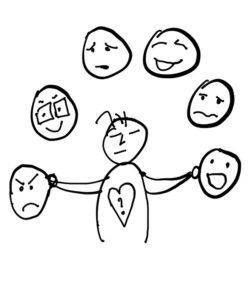
Origins of the Term “Emotional Intelligence”
In 1985 the term “emotional intelligence” was first used in a doctoral dissertation by Wayne Payne. The term “emotional quotient: was later used by Keith Beasley in 1987, and later in 1990, psychologists Peter Salovey and John Mayer published the first article on “Emotional Intelligence” (Impellus, 2020).
There is a need to differentiate between feelings and emotions at this juncture. From the common use of the word “feelings,” one can infer some sense: I feel hungry, cold, and tired. These three sentences refer to a physical state experienced within and by the body (eGyankosh. (n.d). At that level, one cannot say, “I am emotionally hungry, cold, or even tired”. While “I feel” (verb) can be used for a physical state, the word “emotion” is not a verb and cannot be used for a physical state. A feeling therefore is a “general sense [of] what we may feel in any part of our body.
These may be simple bodily sensations, such as hot or cold, pain, touch, or else they may be feelings associated with emotions, such as love or hate, joy or anger” (eGyankosh, n.da).
At the second level, one may say, “I feel angry”. On that note, one can also say, “I am emotional”. At this level, there appears to be a convergence between feel and emotion, though once again, the first is a verb while the second remains a noun. The focus of this paper is on this second meaning of both feeling and emotion.
For the sake of this paper the words “feeling” and “emotion”, shall be used interchangeably to mean this second reaction following a trigger (Voris, 2009).
With this therefore, emotion is described as “[an] abstract, metaphysical state of mind [that offers] essential impressions of the world and one’s relationship with it...[it] establish[es] the person’s attitude toward reality, and provide[s] the needed drive for all of life’s pleasures” ((eGyankosh, n.db)
Emotional intelligence thus entails five competencies:
 (i) Awareness of emotions as well as understanding and expressing feelings; (ii) understanding how others feel and [having the ability to] interact with them; (iii) managing and controlling emotions; (iv) managing change, adapting, and solving problems of a personal/ interpersonal nature; and (v) generating positive effect to enhance self-motivation, to facilitate emotionally and socially intelligent behaviour (Impellus, 2020).
(i) Awareness of emotions as well as understanding and expressing feelings; (ii) understanding how others feel and [having the ability to] interact with them; (iii) managing and controlling emotions; (iv) managing change, adapting, and solving problems of a personal/ interpersonal nature; and (v) generating positive effect to enhance self-motivation, to facilitate emotionally and socially intelligent behaviour (Impellus, 2020).
These five factors are further represented in fifteen sub-factors:
interpersonal relationships, empathy, social responsibility, problem-solving, reality testing, impulse control, emotional expression, assertiveness, independence, self-regard, self-actualization, emotional self-awareness, flexibility, stress tolerance, and optimism (Impellus, 2020).
Importance of Emotional Intelligence in the Workplace

With the convergence between emotional and cognitive intelligence, and with the right attitude to work (job), one is able not only to avoid swaying into wrong pathways, thus stay on the path of continued self and community development, and hence contribute towards social transformation (Bakamana & Kiingati, 2021).
What is the interlink between Emotional Intelligence and Communication Skills for improved and enlightened conduct at work?
For this quest to make sense, there is a need to understand what is communication. In this understanding, the study shall also explore how communication interlinks with emotional intelligence for the self to be more productive at work.
What is Communication?
Shannon and Weaver Model of Communication (2004).

This model shows that communication is the passing of a message from a sender to a receiver.
The sender encodes the message, then chooses a channel through which to pass the message.
Once this is done, the received decodes the message and gives feedback.
In the entire process, there are elements that destruct; these are referred to as noise.
Conclusion
The three components of the self are looked at; each relating to the other. The relationship is through inner communication within the person.
However, each of the three components of the self also relates to significant others (in the figure called interactions).
The self is also treated as an entity that is related to it. The awareness of what both (cognition and emotions) generate and how they manifest in behavior influences self-growth and thus one’s productivity.
The degree to which the self is grown is the degree to which this self shall be able to influence others through interactions, and productivity at work.





